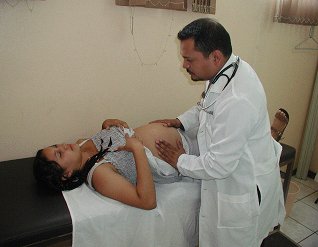Prenatal care: Difference between revisions
→In the United States: merge content to Prenatal care in the United States |
|||
| Line 46: | Line 46: | ||
==In the United States== |
==In the United States== |
||
#REDIRECT [[Prenatal care in the United States]] {{R from merge}} |
|||
{{main|Prenatal care in the United States}} |
{{main|Prenatal care in the United States}} |
||
Revision as of 14:28, 16 March 2012
The examples and perspective in this article may not represent a worldwide view of the subject. (March 2012) |

Prenatal care (also known as antenatal care) refers to the regular medical and nursing care recommended for women during pregnancy.[1][2][3]. Prenatal care is a type of preventative care with the goal of providing regular check-ups that allow doctors or midwives to treat and prevent potential health problems throughout the course of the pregnancy while promoting healthy lifestyles that benefit both mother and child. [4][5] During check-ups, women will receive medical information over maternal physiological changes in pregnancy, biological changes, and prenatal nutrition including prenatal vitamins. Recommendations on management and healthy lifestyle changes are also made during regular check-ups. The availability of routine prenatal care has played a part in reducing maternal death rates and miscarriages as well as birth defects, low birth weight, and other preventable health problems.
Prenatal care generally consists of:
- monthly visits during the first two trimesters (from week 1–28)
- biweekly from 28 to week 36 of pregnancy
- weekly after week 36 (delivery at week 38–40)
- Assessment of parental needs and family dynamic
Prenatal Examinations
Prenatal diagnosis or prenatal screening (note that "Prenatal Diagnosis" and "Prenatal Screening" refer to two different types of tests) is testing for diseases or conditions in a fetus or embryo before it is born. Obstetricians and midwives have the ability to monitor mother's health and prenatal development during pregnancy through series of regular check-ups [4].
Physical examinations generally consist of:
- Collection of (mother's) medical history
- Checking (mother's) blood pressure
- (Mother's) height and weight
- Pelvic exam
- Doppler fetal heart rate monitoring
- (Mother's) blood and urine tests
- Discussion with caregiver
Ultrasound
Obstetric ultrasounds are most commonly performed during the second trimester at approximately week 20. Ultrasounds are considered relatively safe and have been used for over 35 years for monitoring pregnancy.
Among other things, ultrasounds are used to:
- Diagnose pregnancy (uncommon)
- Check for multiple fetuses
- Assess possible risks to the mother (e.g., miscarriage, blighted ovum, ectopic pregnancy, or a molar pregnancy condition)
- Check for fetal malformation (e.g., club foot, spina bifida, cleft palate, clenched fists)
- Determine if an intrauterine growth retardation condition exists
- Note the development of fetal body parts (e.g., heart, brain, liver, stomach, skull, other bones)
- Check the amniotic fluid and umbilical cord for possible problems
- Determine due date (based on measurements and relative developmental progress)
Generally an ultrasound is ordered whenever an abnormality is suspected or along a schedule similar to the following:
- 7 weeks — confirm pregnancy, ensure that it's neither molar or ectopic, determine due date
- 13–14 weeks (some areas) — evaluate the possibility of Down Syndrome
- 18–20 weeks — see the expanded list above
- 34 weeks (some areas) — evaluate size, verify placental position
In the United States
- REDIRECT Prenatal care in the United States
- From a merge: This is a redirect from a page that was merged into another page. This redirect was kept in order to preserve the edit history of this page after its content was merged into the content of the target page. Please do not remove the tag that generates this text (unless the need to recreate content on this page has been demonstrated) or delete this page.
- For redirects with substantive page histories that did not result from page merges use {{R with history}} instead.
Proper prenatal care affects all women of various social background. While availability of such services have considerable personal health and social benefits, socioeconomic problems prevent its universal adoption in both developing and developed nations, such as the US. Although women can benefit by utilizing prenatal care services, there exists various levels of health care accessibility between different demographics throughout the United States.
References
- ^ "Prenatal Care". U.S. National Library of Medicine. 22 February 2012.
- ^ "Definition of Prenatal care". MedicineNet, Inc. 27 Apr 2011.
- ^ W. Schmitt, John (6 March 2009). "Prenatal care fact sheet". U.S. Department of Health and Human Services.
- ^ a b http://www.womenshealth.gov/publications/our-publications/fact-sheet/prenatal-care.cfm. Retrieved on 11 March 2012
- ^ http://medical-dictionary.thefreedictionary.com/prenatal+care. Retrieved on 11 March 2012.
Further reading
- Fiscella K (1995). "Does Prenatal Care Improve Birth Outcomes? A Critical Review". Obstetrics & Gynecology. 85 (3): 468–479. doi:10.1016/0029-7844(94)00408-6. PMID 7862395.
{{cite journal}}: Unknown parameter|month=ignored (help) - Sheiner E, Hallak M, Twizer I, Mazor M, Katz M, Shoham-Vardi I (2001). "Lack of prenatal care in two different societies living in the same region and sharing the same medical facilities". J Obstet Gynaecol. 21 (5): 453–8. doi:10.1080/01443610120071974. PMID 12521796.
{{cite journal}}: Unknown parameter|month=ignored (help)CS1 maint: multiple names: authors list (link) - Howard M, Sellors JW, Jang D; et al. (2003). "Regional distribution of antibodies to herpes simplex virus type 1 (HSV-1) and HSV-2 in men and women in Ontario, Canada". J. Clin. Microbiol. 41 (1): 84–9. doi:10.1128/JCM.41.1.84-89.2003. PMC 149555. PMID 12517830.
{{cite journal}}: Explicit use of et al. in:|author=(help); Unknown parameter|month=ignored (help)CS1 maint: multiple names: authors list (link) - "Prenatal Care - FAQs". Womenshealth.gov. April 2006. Archived from the original on 24 Oct 2008.
- Prenatal Screening Curbs Infant Deaths
- Prenatal ultrasound
- Kids' Lower IQ Scores Linked To Prenatal Pollution